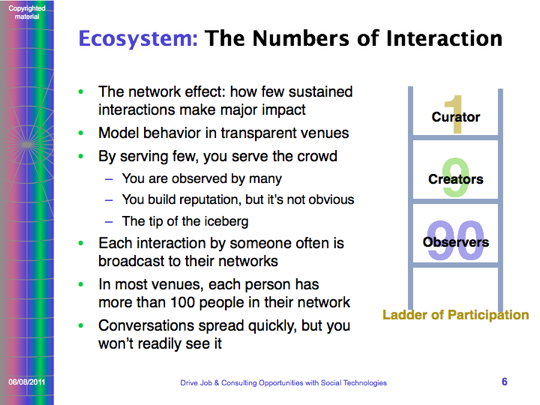Most of us are familiar with Forrester’s Ladder of Participation, but using it to build engagement and community still escapes most individuals and organizations, so here I’ll offer a short treatment within the context of Facebook [click graphic right to enlarge]. The profound insight is that 90% of people in a social venue observe without interacting. 9% are the creators, they tweet, blog and make themselves known. 1% are curators, they sort and categorize content. Whether you are on LinkedIn, Facebook or authoring a blog, you only hear 10% of the people, but you are affecting 100% of the people. If you don’t know that, you might think your online activities were going unnoticed. Now I’ll turn to how this works in Facebook.
Although it isn’t obvious (no one tells you this), Facebook has a natural hierarchy of social actions that makes it easier to build engagement over time—provided you’re looking for it. We are all familiar with most of these things but maybe not with how to use them together. Facebook popularized the concept of “social actions,” which are digital transactions within social contexts. They indicate social connections. Facebook itself is designed to initiate, track and learn about social actions. Here are some examples with which you are familiar.
Facebook Hierarchy of Social Actions
- The Zero ;^) is not a social action, but 90% of viewers of any Facebook Page are lurkers, they don’t do anything except observe, so you really don’t know they are there, but they are watching and being affected by your actions
- The Like is the most primitive type of social action that requires the least commitment; it’s the “thumbs up”
- The Comment is one step up from the Like because the person gives more of him/herself
- The Organic Post shows even more commitment because the person introduces content to a Page by sharing a link, a photo, a video and usually a comment as well
- The Discussion participant reacts to Facebook discussions on a Facebook Page; since discussions are usually more in-depth or serious than Wall banter, this usually signifies more commitment
- The discussion initiator shows the highest commitment and engagement because somebody starts a focused discussion on a Facebook Page; this shows that they want to have a more detailed discussion, and they trust the Page to have the discussion there
Trusting the Hierarchy
Now that we have identified the hierarchy, we can trust it and activate it by recognizing the value in each level. All new Facebook Pages start with little interaction, a few comments or organic posts or likes, because people don’t know what the space is like. The first people who visit your Page are the first guests who arrive at your party. There’s no vibe, no feeling, it’s uncomfortable and uncertain. Therefore, the host of the party is critical, s/he introduces guests to each other, gets them talking. When people like posts on a Facebook Page, thank them and ask them questions, “What did you like the most about the picture?” or “Did you go to that event? How was it?”
Do this at every level of social action. And mean it. You have to be really interested in what other people think, you can’t pay for this or fake it. People will feel it. After a while, everyone will understand that you really want to hear from them, and people will start liking, commenting and posting in greater numbers. But don’t expect them to do it on their own.
Results
The result is very predictable when you are consistent and sincere. Remember the ladder of participation. When people see other people offering pictures and links and being honored by the host, they will be more likely to come out of their shells and interact. The 10% affects the 100%.
In addition, realize that all social networks add “digital grease” to interactions. All have their algos, which automatically broadcast users’ interactions to their networks according to their secret rulesets. Therefore, when someone shares a picture on your Page, it’s broadcast to their networks. When they Like or Comment, same thing. It’s naturally viral. But, when hosts are empathic and ask meaningful questions, they model behavior that reflects, “We are real here” and significantly increases the chance that other people will be real. Which boosts the likelihood of their friends liking the page when they see their friend’s comment on your Page.
The Facebook Page owner is the host of the party, when s/he or they realize their role and fulfill it, traffic and degree of engagement increases steadily.
What are your experiences with this?


[…] are usually asynchronous, they are highly efficient and enable several participant roles (see Ladder of Participation). Remember, your team’s focus is now on helping people create meaningful outcomes with your […]
[…] post Using Facebook’s Ladder of Social Actions to Build Community appeared first on Christopher S. Rollyson and […]
[…] are usually asynchronous, they are highly efficient and enable several participant roles (see Ladder of Participation). Remember, your team’s focus is now on helping people create meaningful outcomes with your […]